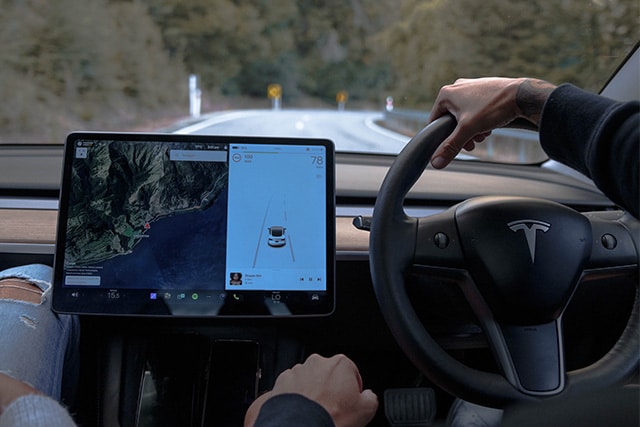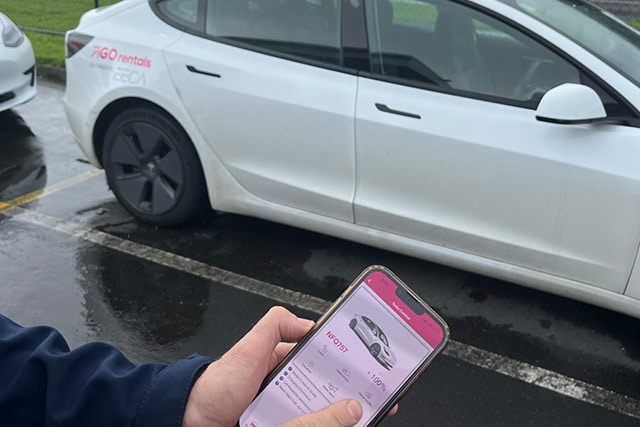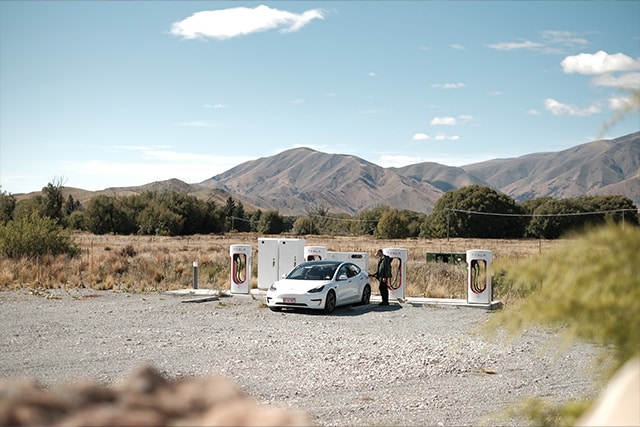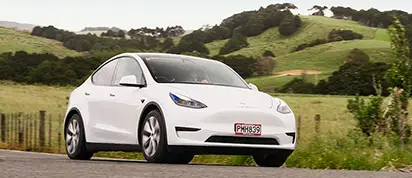Driving an electric car is (surprisingly) simple when you’ve got the basics down pat. In some ways, it’s more straightforward than driving a regular petrol or diesel car.
Whether you’re planning a road trip and looking for an eco-friendly mode of transport, wanting to test drive an electric car for the first time, or are just plain curious, this guide will equip you with everything you need to know to get GOing in your electric car with confidence! We’ll have you meandering the slopes of New Zealand like a pro in no time!
How to drive an electric car: 101
When it comes down to it, operating an electric car boils down to a few simple steps:
- Climb onboard and adjust the mirrors, seat, and steering wheel to your driving preference
- Press the ‘power’ button on the dashboard to turn the car on
- Select ‘drive’ on the gearstick or equivalent rotary dial on your vehicle
- Twist the selector towards the windscreen to go forward, or towards you to reverse
In what ways are electric cars different from traditional fuel-powered vehicles?
Electric cars differ from traditional fuel-powered vehicles in several ways:
- They’re smoother and quieter: Using an electric motor rather than an internal combustion engine (ICE), electric vehicles run more smoothly and quietly than your traditional fuel-powered vehicle. In many countries, it’s mandated that EVs be built with Acoustic Vehicle Alerting Systems (AVAS) to warn pedestrians of their approach. However, this hasn’t yet made its way over to New Zealand.
- Instant torque: Electric motors can deliver maximum torque immediately from a standstill while diesel cars or petrol-fueled engines take time to build up to a peak as RPM increases.
- No gears, no worries: Unlike traditional vehicles, electric cars generally don’t have multiple gears to switch between, making them incredibly easy to operate!
- Regenerative braking: This is one of the most attractive features of an electric vehicle (EV)! It captures kinetic energy during deceleration and converts it into electric energy to recharge the vehicle’s battery. Meaning? You can go further for longer on your electric charge.
- Automatic: Like most good things in this modern world, electric cars are automatic and not manual, making for a cruisey driving experience!
- Physical build: EVs are built differently than traditional vehicles. They tend to have lower centres of gravity (due to the weight of the battery) and more luggage space (as the bulky engine is replaced by an electric motor and there’s no need for an exhaust system, fuel tank, or transmission!)
How to maximise an electric car’s driving range
Maximising the driving range of your electric car is a matter of harnessing some of its core features, including:
Regenerative braking
Regenerative braking allows you to save energy and recharge your car’s battery by using kinetic energy. This enables you to preserve your driving range and charge up less often. In other words, you can go further for longer!
The easiest way to achieve this is to ease off the accelerator when approaching junctions and brake gradually rather than abruptly.
Let yourself coast down hills or on motorways to save energy and activate regenerative braking.
Best ways to utilise regenerative braking for the New Zealand terrain
One of the reasons New Zealand is so perfect for an EV is because of its terrain! With rolling hills, mountains, and lakes, it’s the ultimate playground for a first-time electric car driver!
Navigating the hilly landscape of Dunedin and Wellington is a breeze when you’re mindful of your driving technique and how you can leverage regenerative braking. Follow our top tips below:
- Anticipate downhills: Before you embark on your journey, plan your trip first so that you can take advantage of long downhill stretches. When approaching your descent, ease off the accelerator early to engage regenerative braking.
- Adjust regenerative braking strength: Many EVs will allow you to adjust the strength of your regenerative braking system. Use a stronger setting when you know you’ve got a hilly road ahead.
- Combine with friction brakes: In areas like Wellington – known for its steep streets – combine regenerative braking with friction brakes to maintain safety and control.
- Release the need for speed: Let go of the need for speed and instead, maintain a steady pace to activate regenerative braking frequently. This will also help you reduce your need for friction brakes as often.
Master the art of the one-pedal technique
Many EVs have a one-pedal option that uses regenerative braking to bring the car to a complete stop. This means you only have to use the accelerator to both speed up and slow down, hence the name, “one pedal” driving.
Simply ease off the accelerator pedal to come to a stop and put the pedal to the metal to speed up. Kick the brake pedal to the curb using this technique!
Monitor the range via smartphone apps
These days, most electric cars now come with a smartphone app that lets you monitor their driving range, find the nearest charging locations, and set any preconditioning controls before you get in. These can all help you maximise your driving range.
What’s the most efficient way to drive an electric car?
Just like maximising the range of your EV, there are hot tips that will help you drive your car efficiently – for both your wallet and the environment!
Minimise usage of features
First up, minimise the amount of appliances and car features in use. Similarly to a home, the more features you turn on, the more energy it uses. Switch off the air conditioning or heating when it’s not needed or utilise the preconditioning settings to help regulate the temperature before you get in.
Similarly, disconnect media if you don’t need it. There’s nothing purer than the sound of the Kiwi roads!
Plan ahead
It pays to plan your route and check the weather before jumping in the car. Knowing both these things can help preserve your car’s battery as you can map out where the charging stations are located, make sure they coincide with a mealtime, and precondition the car to a comfortable temp.
If it’s cold weather for example, you can precondition the car to an optimum temperature, or plan to rug up so you’re not using the heat excessively.
Use a light touch
The key to maximising your driving range is to have a light foot. Accelerate smoothly and steadily to preserve power and brake slowly and gradually.
What else do I need to know about driving an EV?
As well as general best practices for how to drive your electric car to maximise efficiency, there are a couple of factors to be mindful of about your electric vehicle:
- Heavier on the bends: Due to their batteries, EVs are generally heavier relative to standard vehicles. This is particularly true around bends but can also vary if you’ve got a more family-style or luxury model.
- Layout: EVs may have a motor in the front, back or both if the car is an AWD (All Wheel Drive).
- Batteries: An electric car’s batteries are usually under the floor, while the charging cable is usually located under the boot floor. This means that they have more boot space than a petrol car, making them ideal for those long road trips!
The benefits of driving an electric car
Part of what makes driving an electric car so appealing is its impact on the environment. But, the plus side doesn’t stop there! Aside from producing 0 emissions when driving, there’s also the added EV benefits of:
- Easy driving: Automatic and with no gears, driving an electric car is super easy. If you’re out in a more secluded area, you get instant power without the need to wait for the gears to engage!
- Cheaper to run and maintain: Because EVs don’t have oily engine parts, they’re often easier to run and maintain. In some public charging locations, it’s even free to charge your car!
- The quiet life: The quiet engine makes for a peaceful drive, especially in the countryside.
How to charge your electric car
In New Zealand, there are over 300 public charging sites for electric cars, making it incredibly easy to charge yours.
Be mindful that some stations are busier than others and have different charging “levels” (in other words, power). The standard charger will get the job done slowly but reliably at around 220-240v. This is what’s commonly referred to as an “overnight charger.”
Leverage off-peak charging
A great way to maximise efficiencies and make the most of those charging stations is to charge your EV off-peak. This way, you can access lower electricity rates for overnight charging.
In New Zealand, these off-peak hours are between 9pm and 7am and weekends may have extended off-peak hours. It’s a good idea to check with your local power network, consult EV charging apps, or check out online resources to find out more!
What happens if an electric car runs out of battery?
Running out of battery isn’t all that common in an EV due to:
- Availability of charging stations around New Zealand: With over 300 existing stations and government plans to increase this, running out of charge isn’t likely. To be extra sure, planning your trip and scheduling in charging can help take the pressure off and give you peace of mind.
- Battery display tools: Most EVs help you monitor your battery levels by displaying how much charge you have left.
- Intelligent design: On top of this, electric cars these days are often fitted out with systems that will alert and notify you when your battery is low, even going as far as to direct you to the closest charging station.
- Preventative measures: As we’ve already walked you through, there are also several ways to prevent rapid battery depletion, such as preparing for weather conditions and minimising car feature usage.
Hire an electric car for your next Kiwi trip!
Driving an electric car really is a simple process and can hold so many benefits for the driver – whether you’re testing it out for an hour or taking an eco-friendly road trip with the family!
With 9 locations across New Zealand, GO Rentals makes it easy to pick up and drop off your electric car rental. As a car hire company moving towards a more sustainable fleet, we’ve got a huge range of hybrid and electric car rentals to choose from! With our helpful driving guides, you can hit the road with ease:
- How to drive a Hybrid car
- How to drive a Tesla Model Y
- How to drive a Tesla Model 3
- How to drive an automatic car
We like to put our money where our mouth is! Our Carbonclick partnership means that you can not only hire an electric car but can offset your car’s carbon emissions if you end up with a petrol car. No emissions, no worries!
Get GOing on your electric car journey today! Book your GO Rentals EV now and drive off into the sunset (or the mountains!)
Book a vehicle for this trip
We recommend:
Premium EV SUV
Tesla Model Y




